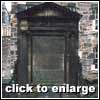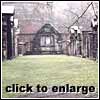
|
Part Nine: The National Covenant and Greyfriars Kirk By Brian Orr Have a question? Click Here to go to Brian's own Discussion Board!
Time has added the embellishment - including a painting by Sir William Allan c. 1840 - that the Covenant was taken outside for signature by the common people gathered there, but truth is that the flat gravestones did not then exist and it was not taken outside. Rather, the following day, March 1, 1638, it was taken to the Tailor's Hall in the Cowgate where burghers and ministers signed and on subsequent days it was taken to other churches for signature.
There were, however, many copies made which were sent to the principal towns of Scotland and to Ireland where local people were able to sign. The original is thought to be that in the Huntley House Museum, but Greyfriars has its own copy in pride of place in the Kirk Session room.
On Sunday, July 23, 1637 at St. Giles Cathedral in the Old City of Edinburgh a woman by the name of Janet Geddes objected to the use of a new prayer book written by Scottish Bishops that was used for the first time. It is said that she threw her small stool at the Dean of the church. Her stool is on display in the Museum of Scotland and the spot from which she threw it is marked by a plate in the floor which reads:
Constant oral tradition affirms that near this spot a brave Scotswoman Janet Geddes on 23 July 1637 struck the first blow in the great struggle for freedom of conscience which after a conflict of half a century ended in the establishment of civil and religious liberty The signing of the document was certainly a momentous occasion and took place in the centre of the Kirk alongside the pulpit. A description of the event is quoted in "The Greyfriars Story - A Celebration", by Padi Mathieson (1990).
"....after it had been read over publicly and a long speech had been made by the Lord Loudoun in commendation thereof, Mr. Alexander Henderson seconded him with a prayer, and then all fell to swear and subscribe, some of the nobility leading the way. The first was John Gordon, Earl of Sutherland, and the next was Sir Andrew Murray, Lord Balvard, minister at Ebdy in Fife: two noblemen who, out of zeal to their profession... thought it a happiness to be amongst the first subscribers and swearers to the Covenant. All who were present at Edinburgh at that meeting in the month of February, subscribed and swore to the Covenant before they went from thence; and at their parting, ministers, and noblemen, and gentlemen, who were well affected to the cause, carried copies thereof along with them, or caused them to be written out after their return to their several parishes and counties of Scotland."The ministers of Greyfriars were active in their resistance to Episcopacy and many suffered for it. The Kirk itself was occupied by Oliver Cromwell's army and saw many confrontations before it again became the focus of the Covenanters.
Within the Kirk yard stands the "Martyrs Memorial" which commemorates some 18,000 Covenanters who died for their faith . It also marks the area where the remains of those executed in the nearby Grassmarket are buried. The inscription reads: Halt passenger take heed what thou dost see  From May 27th 1661 that the noble Marquess of Argyle suffered to the 17th of Febr 1688 that Mr James Ranwick suffr'd were executed at Edinburgh about an hundred of Noblemen Gentelemen Ministers & others noble martyrs for JESUS CHRIST. The most part of them lies here.
From May 27th 1661 that the noble Marquess of Argyle suffered to the 17th of Febr 1688 that Mr James Ranwick suffr'd were executed at Edinburgh about an hundred of Noblemen Gentelemen Ministers & others noble martyrs for JESUS CHRIST. The most part of them lies here.
This Tomb was erected anno 1706. Ironically, nearby the "Prison" stands the mausoleum of Sir George MacKenzie who, as Kings Advocate, was responsible for the zealous prosecution of the Covenanters and gained for himself the title "Bluidy" MacKenzie.
Meet the Author, Brian Orr, Researcher with The Guild of One Name Studies
Back to The Covenanters, Main Page
Part One: The Covenanters: Who Were They?
|
Thursday, December 26th, 2019
Attention visitors: Tartans.com is back. Please note that this is a snapshot of the site as it existed nearly 20 years ago and you may encounter broken links; we are still combing through the site and correcting those as we find them. Please also note that some sections are currently not functional, primarily the discussion forums/clan chat boards.
|
** HOME - First Time Visitors - Glossary - - Contact Us ** Awards | Bibliography | Clan Calendar | Clan Chat | Clan Finder | History | Famous Scots | Genealogy | Great Hall of the Clans | Links | News and Features | Scots on the Net | Search | Site Map The Gathering of the Clans
Copyright 1995- Tartans.com - All Rights Reserved. |



